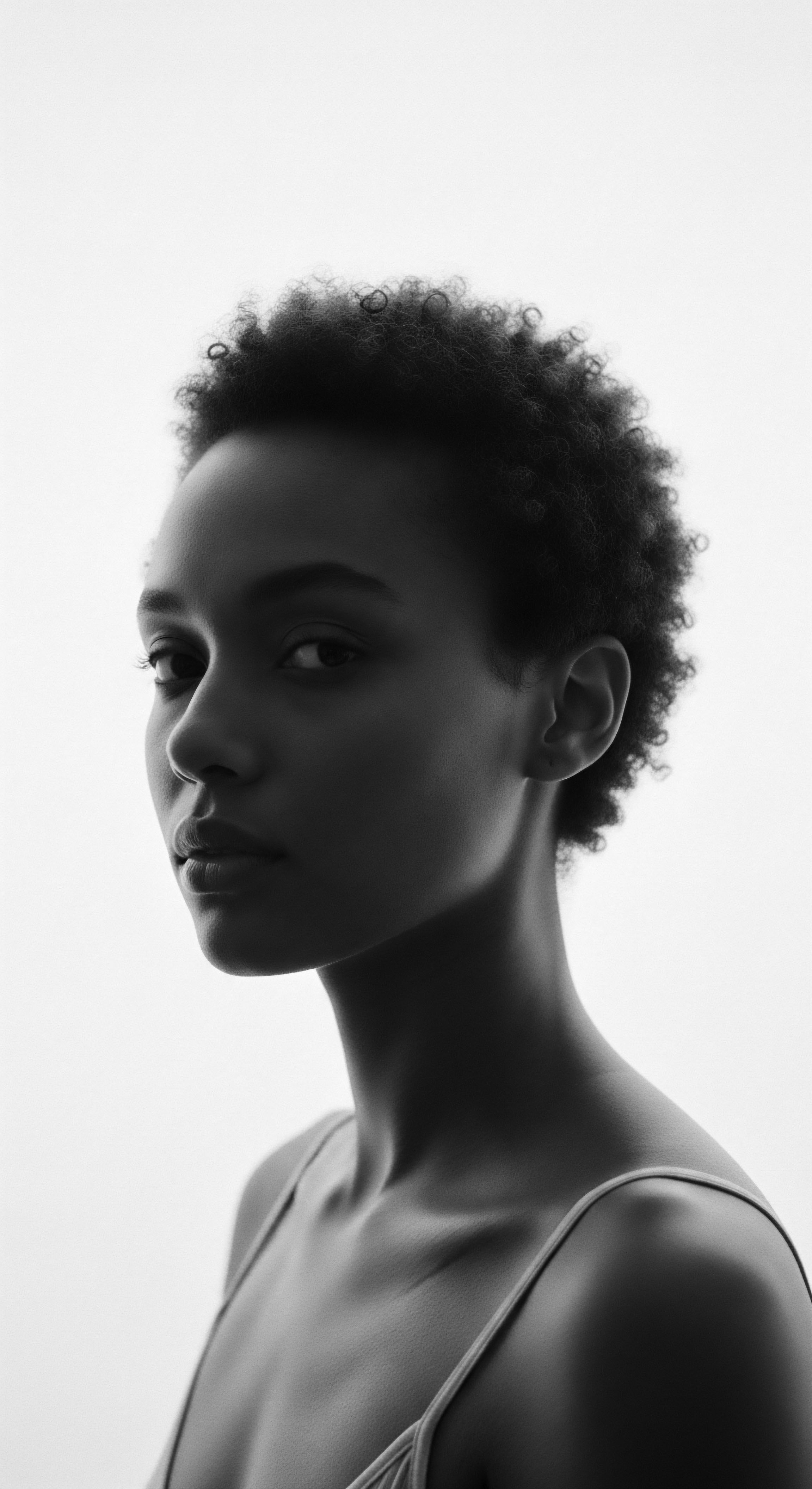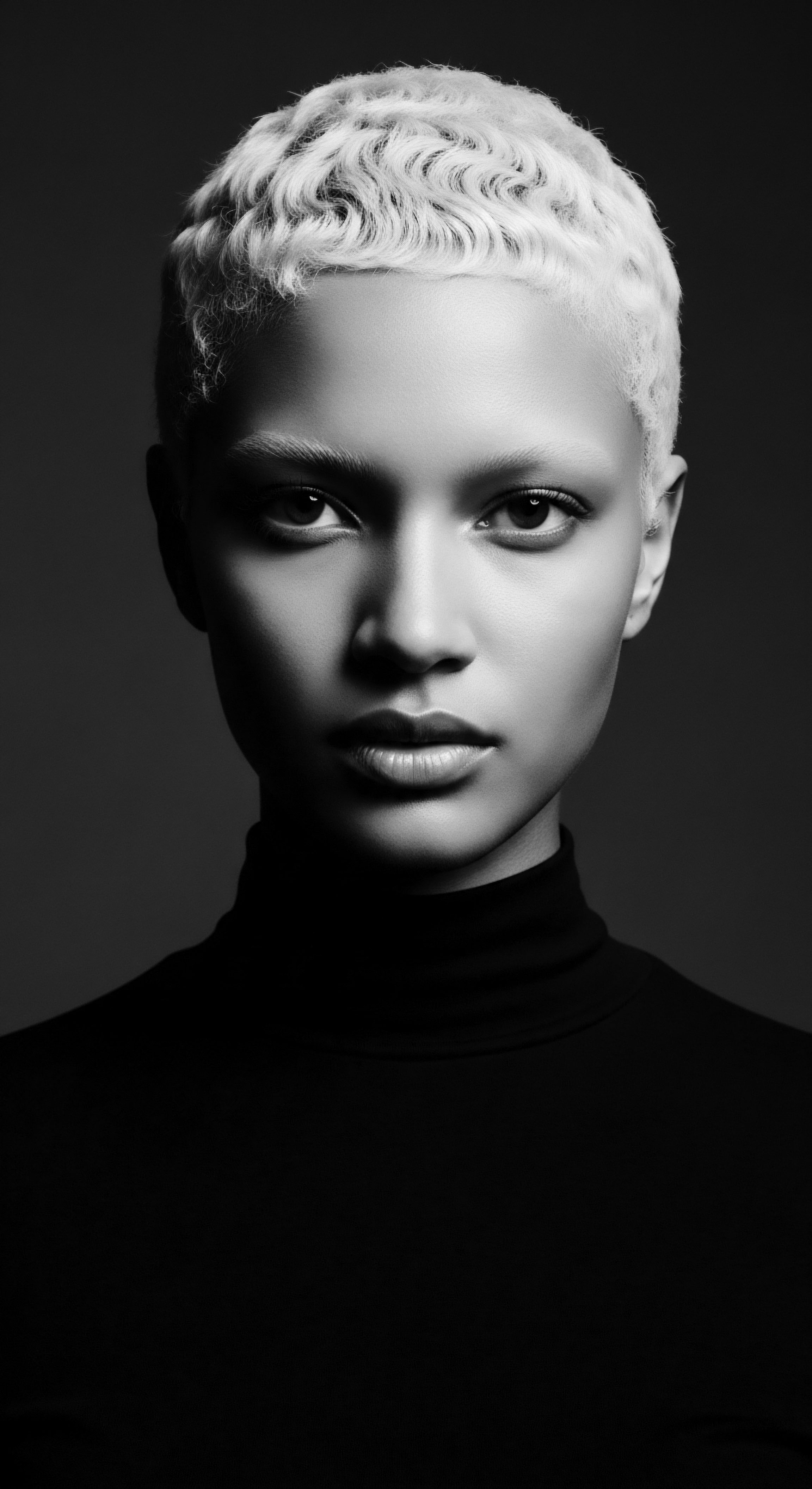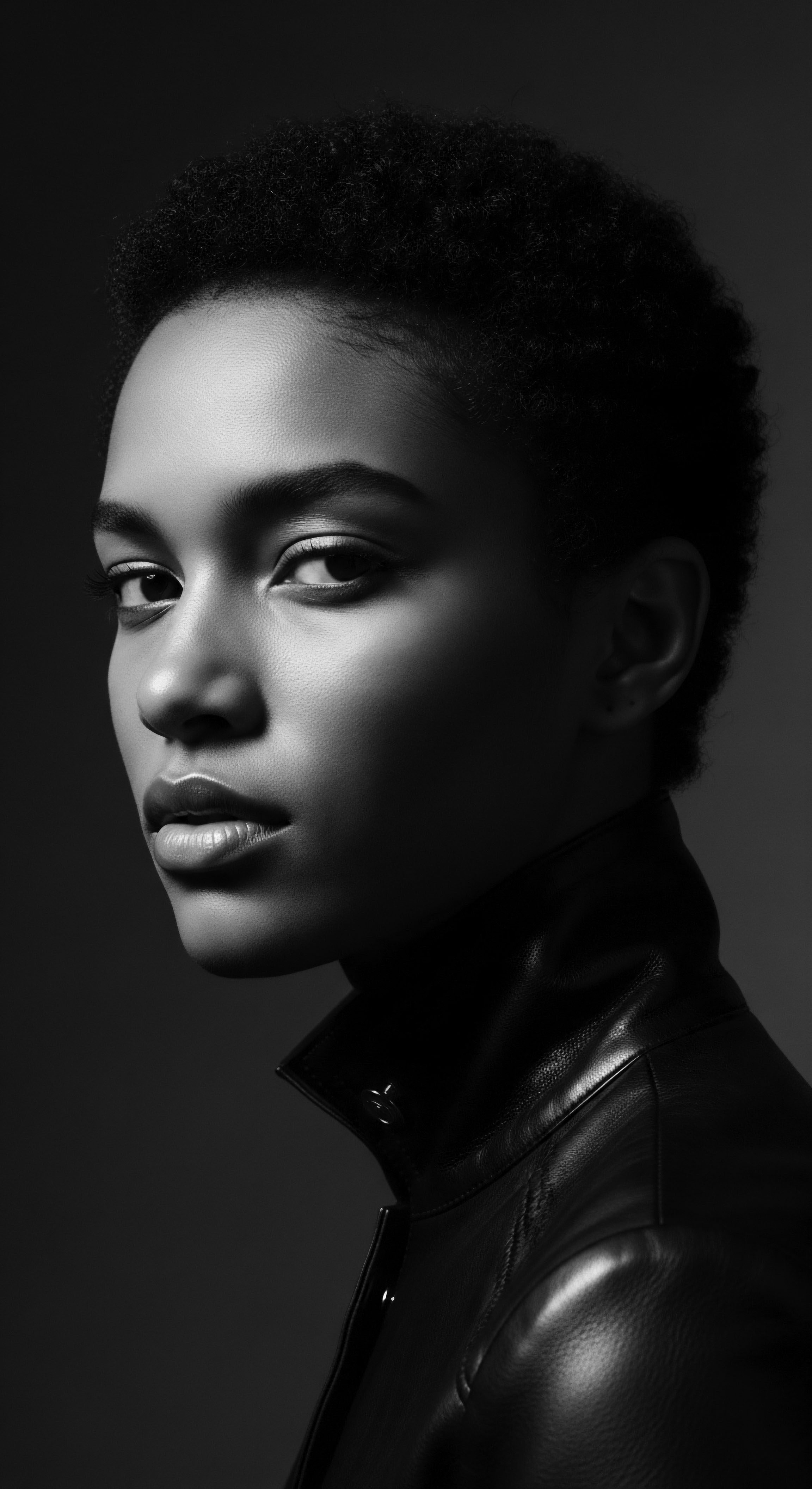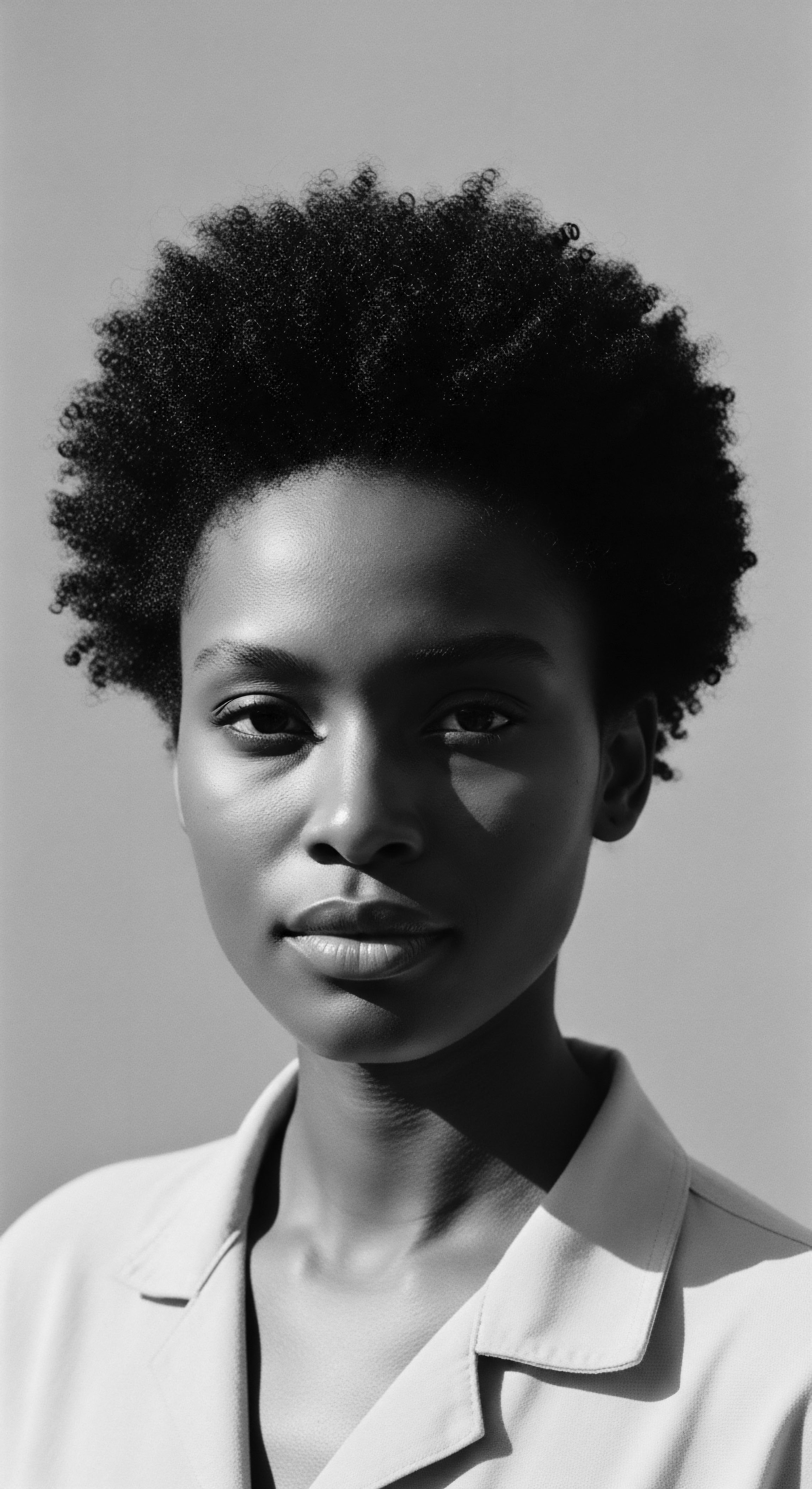
Roots
To stand upon the fertile ground of textured hair care, we must first recognize the deep soil from which it springs. For those of us whose strands dance with spirals, coils, and waves, understanding our hair is a sacred dialogue, a conversation whispered across generations and rooted in the very structure of our being. The inquiry into how hair follicles affect textured hair care is not a sterile scientific query alone; it is an invitation to acknowledge a lineage, a heritage carried not only in stories and traditions, but in the biological architecture of each individual strand. Our hair, in its myriad expressions, holds within its very fiber the echoes of ancestors, their resilience, and their wisdom.
Consider the subtle curve of the hair follicle, nestled beneath the scalp. This seemingly small detail dictates the very spirit of our textured hair. Straight hair typically emerges from a round follicle, allowing a smooth, even journey upwards. For those with waves, curls, or coils, the follicle takes on an oval, elliptical, or even S-shaped contour.
This non-circular opening causes the hair strand to bend and twist as it grows, creating the distinct curl patterns we celebrate today. The more pronounced the oval or S-shape, the tighter the curl or coil will be. This fundamental truth shapes how our hair presents itself, how it absorbs moisture, and how it responds to the world around it.

Hair’s Ancestral Blueprint
The origins of varied hair textures are as old as humanity itself. Scientists believe that highly coiled hair, for example, may have served as an evolutionary adaptation in hot climates, providing protection from intense ultraviolet radiation while allowing for air circulation to the scalp. This speaks to a profound connection between our biology and the environments our ancestors inhabited, demonstrating how the very makeup of our hair follicles contributed to survival and well-being long before the advent of modern hair care routines. This ancient blueprint, etched into our DNA and expressed through the shape of our follicles, forms the cornerstone of textured hair heritage.
The varied curvature of hair follicles means that natural oils, or sebum, produced by the scalp, do not easily travel down the length of a coiled or kinky strand. This inherent dryness is a biological fact for many with textured hair. It means that what might suffice for straight hair a simple wash and go becomes a more considered, thoughtful practice for coiled hair.
The need for consistent moisture, the understanding of porosity how well hair absorbs and retains water becomes paramount. This understanding, in turn, informs care practices passed down through families and communities.
The shape of the hair follicle determines the very essence of a textured strand, dictating its unique curl pattern and its interaction with moisture.

Understanding Hair Structure Beyond the Surface
Beyond the visible curl, the hair follicle influences other properties of textured hair. The size of the follicle dictates the thickness of the hair strand; larger follicles yield thicker, coarser hair, while smaller follicles produce finer strands. Moreover, the arrangement and density of follicles can vary across the scalp, leading to different curl patterns and thicknesses even on the same head. This biological variability adds to the unique beauty of textured hair and explains why a “one-size-fits-all” approach to care is rarely effective.
The chemical bonds within the hair, particularly disulfide bonds, also play a significant part in curl formation. These bonds create tension within the hair fiber. In coiled hair, these bonds are often more numerous and compacted due to the curved nature of the follicle, contributing to the hair’s tighter formation. This structural reality highlights why textured hair, while resilient, can also be more prone to dryness or mechanical damage if not handled with particular understanding and care.
Early Attempts to Categorize Hair often reflected societal biases more than scientific accuracy. Before the modern Andre Walker system, which gained prominence in the 1990s, earlier classifications, some dating back to the early 1900s, were used to categorize hair based on race, with terms such as “Negroid,” “Caucasoid,” and “Mongoloid.” These systems, like the one developed by Eugen Fischer in 1908, a German Nazi scientist, were often rooted in racist ideologies to determine a person’s proximity to whiteness based on their hair texture. The infamous Apartheid Pencil Test also served a similar, oppressive purpose. This fraught history underscores why the language and systems we use to describe textured hair carry such weight and must be approached with sensitivity and an awareness of their origins.
| Follicle Shape Round |
| Hair Type Generally Produced Straight Hair |
| Heritage Context / Implication for Care Common in various global populations. Often allows sebum to travel easily, reducing dryness. |
| Follicle Shape Slightly Oval |
| Hair Type Generally Produced Wavy Hair |
| Heritage Context / Implication for Care A transitional form, sometimes displaying more volume at the root. May require less moisture than tighter curls. |
| Follicle Shape Oval / Elliptical |
| Hair Type Generally Produced Curly Hair |
| Heritage Context / Implication for Care Seen across diverse populations, with higher prevalence in African and diasporic communities. Hair tends toward dryness due to curl pattern, necessitating hydration. |
| Follicle Shape Highly Oval / Almost Flat / S-shaped |
| Hair Type Generally Produced Coily / Kinky Hair |
| Heritage Context / Implication for Care Predominant in individuals of African descent, possibly an evolutionary adaptation. Requires significant moisture, gentle handling, and protective measures to counteract dryness and potential breakage. |
| Follicle Shape Understanding these shapes connects our biological makeup to inherited hair care needs, linking us to ancestral adaptations and practices. |

Ritual
The legacy of textured hair care extends far beyond biological inclinations; it breathes through the living traditions, the conscious actions, and the communal gatherings that have shaped practices for generations. When we consider how hair follicles affect textured hair care within this context of ritual, we are speaking to the informed choices made over centuries. These choices were often made to accommodate the unique requirements of highly curved strands, choices that predated scientific laboratories and were instead perfected through observation, ancestral wisdom, and shared experience.
For communities with textured hair, care practices have long been a blend of art and necessity. The natural inclination of coiled hair to be drier, as its inherent twists hinder the downward flow of scalp oils, compelled communities to develop ingenious methods for moisture retention. This led to the widespread use of natural emollients and protectants, practices now validated by contemporary science. These traditional methods addressed the intrinsic properties determined by the hair follicle, ensuring the hair remained healthy and strong.

Ancestral Styling Practices
Protective styles, such as braids, twists, and cornrows, are not merely aesthetic choices; they are historical declarations, techniques honed over millennia to shield hair from environmental elements and reduce breakage. These styles, some dating back to 3500 BCE in African cultures, served multiple purposes beyond protection. They signified identity, social standing, marital status, and even religion within various tribes.
The knowledge that hair follicles dictate the vulnerability of highly curved strands to tangling and breakage explains why these methods became so central to ancestral care. By tucking away the hair, these styles minimize manipulation, preserving the integrity of the hair shaft and honoring its natural state.
Protective styles are a living archive of ingenuity, born from a deep understanding of textured hair’s biological needs and cultural significance.
Consider the historical use of hair oils and butters in African communities. Ingredients like Shea Butter, Marula Oil, and African Black Soap were not random selections; they were chosen for their moisturizing and protective qualities, often passed down through family lines. These substances naturally address the dryness inherent to many textured hair types, which is directly influenced by the hair follicle’s curved shape. By regularly applying these emollients, ancestral communities were intuitively compensating for the biological challenge of sebum distribution, a challenge rooted in follicle morphology.
- Shea Butter ❉ Derived from the nuts of the shea tree, revered for its moisturizing and healing qualities. Its rich composition of vitamins and fatty acids provides deep hydration, crucial for coiled strands.
- African Black Soap ❉ Traditionally made from plantain skins and palm oil, used for gentle cleansing without stripping natural oils. This respects the hair’s need to retain moisture.
- Marula Oil ❉ A traditional oil from Southern Africa, recognized for its antioxidant properties and use in moisturizing skin and hair.
- Chebe Powder ❉ Originating from Chad, a blend of various plants known for increasing hair thickness and moisture retention.

How Did Ancient Practices Adapt to Follicle Characteristics?
The methods employed by ancient peoples demonstrate an astute awareness, perhaps not formalized in scientific terms, of how hair follicles affect textured hair care. They understood that highly coiled hair required different handling. They prioritized methods that reduced friction, preserved moisture, and minimized stress on the hair shaft, instinctively responding to the hair’s fragility at its bends, a fragility linked to its elliptical cross-section and protein structure formed at the follicle.
For instance, the practice of braiding hair wet or damp, common in many ancestral cultures, helps to clump strands together, reducing tangling and providing a smooth foundation for the protective style. This also helps to seal in moisture before the hair dries, directly countering the natural dryness associated with the follicle’s curved growth path. The careful sectioning and tension applied during braiding reflect an understanding of distributing stress evenly across the scalp, a practice that safeguards the hair follicle and its emerging strand.
| Ancestral Practice / Ingredient Protective Braiding (e.g. Cornrows, Bantu Knots) |
| Heritage Significance Identity marker, social status, spiritual connection, historical communication tool. |
| Connection to Follicle Biology & Care Minimizes mechanical stress on hair shaft and follicle, reduces tangling and breakage common in highly coiled hair due to elliptical follicle shape and asymmetrical growth. |
| Ancestral Practice / Ingredient Use of Natural Butters & Oils (e.g. Shea, Marula, Coconut) |
| Heritage Significance Tradition, holistic well-being, community rituals. |
| Connection to Follicle Biology & Care Compensates for inherent dryness of coiled hair (sebum struggles to travel curved strands from follicle); provides lubrication and a moisture barrier to hair emerging from oval follicles. |
| Ancestral Practice / Ingredient Gentle Detangling (e.g. finger combing, wet detangling) |
| Heritage Significance Patience, self-care, shared ritual. |
| Connection to Follicle Biology & Care Acknowledges the increased propensity for tangles and knots in textured hair, a direct consequence of the hair's spring-like structure and elliptical cross-section formed at the follicle. Reduces damage to the cuticle and hair shaft. |
| Ancestral Practice / Ingredient These enduring practices reveal a profound ancestral understanding of textured hair, long before scientific definitions of follicle morphology existed. |

Relay
The journey of understanding how hair follicles affect textured hair care continues, carrying forward the wisdom of past generations into our present moment. This relay of knowledge is not static; it is a dynamic interplay, where ancestral practices meet contemporary scientific insight, deepening our appreciation for the biological foundations of our heritage. We see how the microscopic world of the hair follicle influences macroscopic care, shaping routines and affirming the efficacy of long-held traditions.
The very shape of the hair follicle, a feature determined during embryonic development, defines the curl pattern for life. An oval or S-shaped follicle produces hair that is similarly elliptical in cross-section. This elliptical shape, along with the varying angle at which the follicle emerges from the scalp, causes the hair strand to spiral as it grows. This structural reality is central to the care of textured hair because it contributes directly to several key characteristics ❉ its natural tendency towards dryness, its propensity for tangling, and its vulnerability at the bends of its coils.

Porosity and Follicle Morphology
The concept of Porosity, which describes how readily hair absorbs and retains moisture, is intimately connected to the hair follicle’s output. Hair with tighter curls often exhibits higher porosity due to its raised cuticle layers or gaps along the hair shaft, which allows moisture to enter easily but also escape quickly. This is a direct consequence of the hair’s unique structure, influenced by the asymmetrical growth from its curved follicle. Knowing one’s hair porosity, therefore, is a contemporary extension of ancestral wisdom that prioritizes hydration.
Hair with low porosity, for example, has tightly closed cuticles, making it resistant to moisture absorption initially, but once hydrated, it retains moisture well. These differing needs, though scientifically described now, align with the varied approaches to oiling and conditioning found in historical practices.
A powerful historical example that illuminates the connection between hair follicle characteristics and care within Black experiences is the Apartheid Pencil Test. This deeply discriminatory practice, instituted during the mid-20th century, utilized the natural coiling of hair, a direct manifestation of the hair follicle’s shape and angle of growth, as a tool for racial categorization. If a pencil could be held within a person’s hair when shaken, they were classified as Black, denying them the privileges afforded to white individuals.
This stark reality showcases how the very biological attributes of textured hair, rooted in the hair follicle, were weaponized to enforce social hierarchy and oppression. It underscores the profound historical and cultural weight carried by Black hair, transforming its care from a mere aesthetic pursuit into an act of reclaiming identity and dignity.

Nighttime Care and Ancestral Wisdom
The care of textured hair extends into the nighttime hours, a ritual that speaks volumes about protecting the hair shaft from environmental friction. The use of bonnets and headwraps, common in Black and mixed-race communities, has a history extending back centuries. In ancient Egypt, head coverings offered hair protection from harsh elements.
During enslavement, these head coverings were tragically weaponized to strip enslaved Black women of their identity and cultural expression. Yet, resiliently, Black women reclaimed bonnets as symbols of cultural pride, self-expression, and, crucially, as a practical tool for hair preservation.
The practical benefit of these coverings is directly tied to the fragility of textured hair. When hair with a highly elliptical cross-section is rubbed against abrasive surfaces like cotton pillowcases, it can lead to friction, tangles, and breakage. Bonnets, typically made of smooth materials like silk or satin, create a protective barrier, reducing friction, preserving moisture, and minimizing manipulation of the curls formed by the unique follicle shape. This ritual, born of historical necessity and cultural resilience, safeguards the hair’s integrity, allowing its natural beauty to persist.
- Silk or Satin Bonnets ❉ These coverings reduce friction against hair, preventing breakage and preserving moisture, a need amplified by the natural dryness of highly coiled hair originating from curved follicles.
- Pineapple Method ❉ Gathering hair loosely on top of the head before covering, a modern technique that minimizes compression and retains curl definition.
- Moisturizing Before Bed ❉ Applying leave-in conditioners or light oils to further seal moisture into strands, addressing the inherent moisture challenges of textured hair.

Ingredients and Their Scientific Alignment
Many traditional ingredients, long celebrated in ancestral hair care, now find scientific validation for their benefits to textured hair, directly addressing the characteristics imparted by its follicle.
- Shea Butter ❉ Its rich emollients provide a protective barrier, helping to seal in moisture and reduce transepidermal water loss, especially beneficial for hair that is prone to dryness due to its coiled structure.
- Coconut Oil ❉ Known for its ability to penetrate the hair shaft, reducing protein loss and providing deep conditioning, supporting the structural integrity of hair prone to breakage at its bends.
- Aloe Vera ❉ Used for centuries for its soothing and hydrating properties, it calms the scalp and provides moisture to the hair, particularly important given the challenges of sebum distribution in coiled hair.
These components, utilized throughout history, offer topical nutrition, supporting the hair shaft from root to tip, complementing the biological reality of how hair follicles affect textured hair care. They attest to a symbiotic relationship between inherited hair characteristics and the ancestral wisdom that recognized and cared for them. The relay of this knowledge empowers contemporary care, connecting us to a vibrant, enduring heritage of wellness.
The historical use of bonnets and natural emollients reflects an enduring understanding of textured hair’s needs, predating modern science.

Reflection
As we come to the close of this exploration, the echoes of textured hair heritage resound, affirming that how hair follicles affect textured hair care is far more than a biological detail. It is the very source from which a rich and enduring cultural legacy flows. Each curl, each coil, each wave carries the indelible mark of ancestry, a testament to resilience, adaptation, and profound beauty.
We have seen how the microscopic architecture of the hair follicle shapes the hair’s journey from beneath the scalp, dictating its unique needs for moisture, protection, and gentle handling. This intrinsic design has, through generations, guided the development of care rituals, styling traditions, and even expressions of identity across Black and mixed-race communities.
The ancestral wisdom, passed down through the ages, intuiting what science now confirms about hair follicle morphology and its implications, stands as a beacon. The dedication to protective styles, the reverence for natural ingredients like shea butter and marula oil, the nighttime ritual of bonnet protection these are not mere practices but living traditions that speak to a profound connection with the self and a collective past. Our hair, truly, is a living, breathing archive, each strand a chronicle of adaptation, resistance, and self-celebration.
It reminds us that care is not just about maintenance; it is about honoring lineage, about respecting the inherited blueprint, and about connecting with the ‘Soul of a Strand’ that binds us to a heritage as deep and complex as the human story itself. To understand the follicle’s role is to grasp the deeper narrative of Black and mixed-race hair, ensuring that its care remains an act of love, informed by both ancient wisdom and evolving knowledge.

References
- Byrdie. (2021, October 25). The Controversial History of the Hair Typing System.
- Curl Witch. (2024, September 30). The Science of Hair Texture ❉ Understanding Curl Patterns.
- Cabela. (2025, April 2). CURLY BY DESIGN ❉ How your hair follicles shape your curls.
- Natural Hair Berlin. (n.d.). Curly Hair Science ❉ Understanding Hair Structure, Follicles & Porosity.
- Helix Hair Labs. (2023, March 3). THE HISTORY OF THE HAIR BONNET.
- Paramount Beauty. (2015, August 10). Learn the Science of Curly Hair.
- The Purple Pulse. (2024, January 21). Protective hairstyles hold cultural significance.
- Forbes. (2022, July 24). 4c Hair Discrimination ❉ An Exploration Of Texturism.
- Substack. (2025, May 4). Ancestral Hair Rituals to Nourish Your Hair and Soul.
- Team True Beauty. (2023, December 7). The Significance and History of Black People Bonnets.
- Afriklens. (2024, November 1). African Hairstyles ❉ Cultural Significance and Legacy.
- EBSCO Research Starters. (n.d.). Afro-textured Hair.
- My Sasun. (2023, May 19). Exploring the Rich World of Nigerian Hair and Beauty Products.
